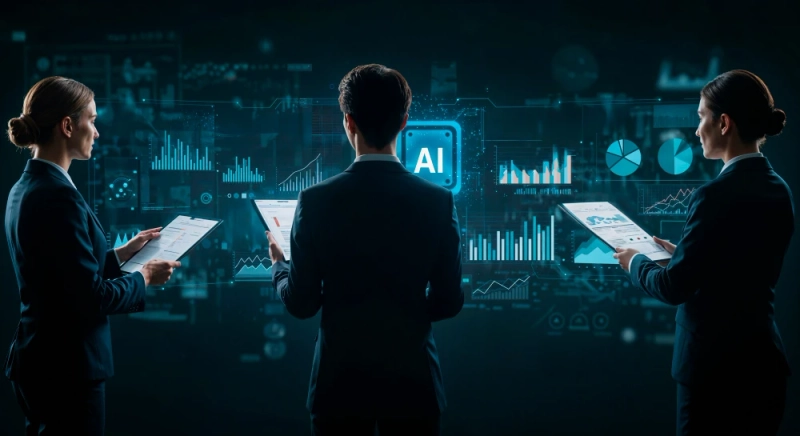In 2025, AI software development companies are pushing the boundaries of innovation, integrating cutting-edge technologies to stay ahead of competitors. From ethical AI frameworks to the rise of generative models, these trends are redefining the way businesses build intelligent solutions. As demand for more efficient, scalable, and responsible AI systems grows, companies are embracing new approaches to boost performance and user experience.
This piece examines the innovative technology trends that will shape the future of an AI software development company in 2025 and beyond.
AI-Powered Code Generation
AI-powered code generation has transformed how software development teams work across the globe. Manual coding for repetitive tasks has given way to AI-assisted development that complements human creativity and problem-solving skills.
AI-Powered Code Generation with GitHub Copilot
GitHub Copilot leads AI-powered coding tools by offering smart suggestions that improve developer workflows. This AI assistant provides contextual code recommendations through machine learning and works like a virtual pair programmer. A study conducted by Microsoft Research found that developers using GitHub Copilot completed tasks 55.8% faster in a controlled experiment.
AI-Powered Code Generation and Developer Productivity
The benefits of AI code generation go beyond just speed. McKinsey's research highlights four areas where generative AI tools enable massive productivity gains:
- Expediting manual and repetitive work
- Jump-starting first drafts of new code
- Accelerating updates to existing code
- Improving developers' skills to tackle new challenges
AI code generation tools will become more integrated into development workflows as they evolve. Many companies now test applicants with GitHub Copilot during hiring. This depicts that AI pair programming skills have become essential for software developers. Companies that use AI coding tools effectively will gain advantages in development speed, code quality, and talent retention.
Multimodal and Context-Aware AI Systems
Multimodal AI is leading the charge in software development. These systems process and integrate multiple types of data simultaneously. Unlike traditional AI, which works with just text or images, multimodal systems can understand and create combinations of text, images, audio, and video. This lets AI "see," "hear," and "speak" in ways that feel more human.
Multimodal and Context-Aware AI Systems in UX
Context-aware user experience design enables digital products to recognize, interpret, and adapt to users' environments, preferences, and needs. Users don't work with digital products in a vacuum. Their surroundings shape how they interact with technology.
AI software development companies in 2025 are building context-aware UX that adapts to:
- Location and activity (driving versus walking)
- Device type and network speed
- Time of day and external conditions
- User's emotional state
Combined with multimodal features, these systems create easy-to-use interfaces.
Multimodal and Context-Aware AI Systems in Assistants
AI assistants have come a long way from text-only chats. Better memory, reasoning, and multimodal abilities let these systems handle complex tasks more independently. Modern assistants work with text, voice, images, and video inputs all at once.
Microsoft's Copilot depicts this growth through features like Copilot Vision. By understanding web pages, it can engage in discussions about what users are viewing and suggest relevant actions. ChatGPT now accepts image inputs and voice commands too. Users can take pictures of objects and ask questions about them or just talk naturally and get voice responses.
AI software development services can now create more helpful assistants that:
- Process visual and audio information alongside text
- Identify different voices to offer personalized responses
- Detect emotional cues in customer chats
Edge AI and Real-Time Decision Making
Edge computing is changing how an AI software development company delivers immediate intelligence in applications where speed counts most. Moving artificial intelligence processing from centralized cloud servers to local devices lets Edge AI make split-second decisions without network delays.
Edge AI brings intelligence directly to the source by embedding AI algorithms into devices connected to equipment and machinery. Local processing removes the latency associated with cloud-based AI. This immediate responsiveness allows teams to analyze data and act instantly as events unfold.
Edge AI in Consumer Devices
Smart consumer technology gets even better with Edge AI integration. Smartphones now adjust battery use based on your habits, and cars analyze sensor data immediately. As Edge AI continues to evolve, its presence in everyday devices becomes more seamless and widespread.
AI-powered smart glasses showcase the future of personalized technology. These devices give you tailored experiences through local data processing, which leads to more intuitive and private interactions. Edge AI also enhances modern vehicles by leveraging sensors, cameras, and advanced processors to create smarter, more responsive driving experiences.
Edge AI in Manufacturing and Healthcare
Manufacturing plants are embracing Edge AI to enhance efficiency and minimize downtime. An AI software development company builds systems that identify issues right away, which prevents costly delays.
Edge AI is transforming healthcare in ways cloud-based systems can't match. Smart wearables track health data in real-time, which helps doctors monitor patients from anywhere. Rural areas benefit from AI-powered diagnostic tools. Portable equipment brings diagnosis right to patients instead of making them travel far.
Even astronauts rely on Edge AI—on the International Space Station, edge devices continuously analyze air, water, and surfaces for harmful microbes. This ensures safety in space environments.
Custom AI Models and Democratized Development
AI model development is becoming more accessible to organizations of all sizes. Advancements in technology are reducing technical barriers, making custom AI solutions easier to adapt and train. Companies can now create their own artificial intelligence systems that meet their specific needs without massive computing resources or specialized expertise.
Custom AI Models with LoRA and RAG
Low-Rank Adaptation (LoRA) has become a breakthrough technique to efficiently customize large language models. LoRA solves problems in traditional fine-tuning by freezing pre-trained model weights and adding trainable rank decomposition matrices into each layer of the Transformer architecture. This method cuts down the number of trainable parameters by up to 10,000 times compared to full fine-tuning.
Retrieval-Augmented Generation (RAG) offers another way to enhance generative models by integrating external information sources during the generation process. RAG retrieves relevant information instead of relying only on pre-trained knowledge, which improves accuracy and relevance. Organizations with limited fine-tuning capabilities find this technique valuable because it enriches model outputs with current, context-specific information.
These technologies serve different purposes. LoRA excels at domain-specific customization in specialized contexts like medical, legal, or financial sectors. RAG works best in dynamic scenarios that need up-to-date information, such as technical support or customer relationship management.
Custom AI Models and AI Software Development Services
An AI software development company aims to meet the growing need for customized solutions with specialized services. These custom AI models work better than off-the-shelf options in several ways:
They easily integrate with existing systems and databases, using company-specific data for optimal performance. AI models deliver higher value by solving targeted business challenges rather than broad, generic problems.
Custom AI solutions are becoming more available through AI-as-a-Service platforms. These services let small businesses access advanced AI capabilities—such as machine learning algorithms, predictive analytics, and automation—through subscriptions.
Ethical AI and Regulatory Compliance
AI software development companies are evolving to meet new regulatory frameworks as governments worldwide establish guidelines for AI-driven decision-making. These guidelines ensure respect for fundamental rights while encouraging new breakthroughs.
Ethical AI and the EU AI Act
The EU AI Act leads the world as the first detailed legal framework for artificial intelligence. It adopts a risk-based approach and categorizes AI systems based on their potential impact on safety and fundamental rights. The framework bans AI applications that pose unacceptable risks, such as:
- Cognitive behavioral manipulation
- Social scoring systems
- Biometric identification in public spaces
- Real-time facial recognition (with limited exceptions)
The Act requires strict measures for high-risk AI systems in critical sectors like healthcare, education, and law enforcement. These include risk assessments, quality datasets, thorough documentation, and human oversight. Even popular AI models like ChatGPT must meet transparency standards and follow EU copyright law.
Ethical AI and Bias Mitigation
An artificial intelligence software development company often faces its biggest problem in dealing with biased systems. Biased algorithms create unfair outcomes that can worsen social inequalities, break regulations, and harm an organization's reputation.
Teams need several approaches to tackle bias effectively. Having diverse team members helps spot potential biases that uniform groups might miss. The right feature selection during development reduces exclusion bias by removing unnecessary data points.
Conclusion
AI software development continues to evolve rapidly, and emerging trends paint a clear picture of what lies ahead. AI-powered code generation tools like GitHub Copilot have changed how developers work. These tools boost productivity and make jobs more satisfying. Developers can now focus on solving creative problems instead of doing repetitive coding tasks.
An AI software development company must learn and adapt constantly to stay updated with emerging trends. Organizations that guide through this changing landscape will create immense value for their clients while pushing responsible AI forward. Challenges exist, but the benefits of smart AI use far exceed the hurdles. The future of AI lies in enhancing human capabilities, not replacing them. This ushers in an era where innovation and ethics drive progress.


